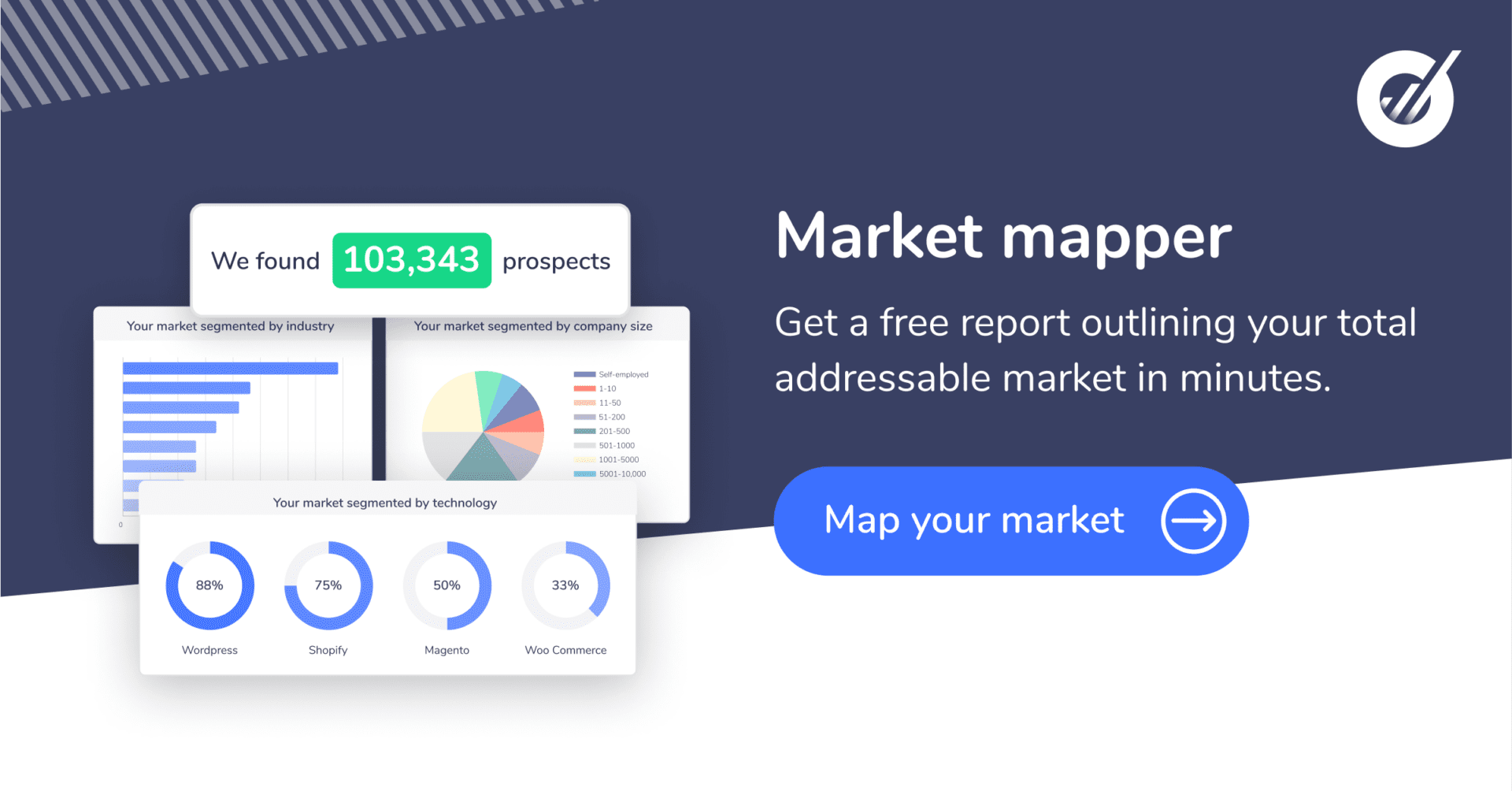How to identify and contact your B2B target market
In this blog
- Why do you need to know your target market?
- Target market vs target audience: what’s the difference?
- How to find your B2B target market
- B2B target market segmentation
- What is B2B target market segmentation?
- 3 bonus tips for finding your B2B target audiences
- How to contact your target market
- Get talking to your target market right now

Why you need to know your B2B target market, how to identify and segment them, and the best ways to start reaching out.
In the competitive B2B landscape, knowing your audience is the key to winning big. You’ve got to find the right decision-makers and connect with them effectively.
Understanding your target market isn’t ground-breaking, but the game has changed. The digital revolution has brought new opportunities and challenges. So we’re exploring the essential steps and techniques to navigate this dynamic terrain and build meaningful relationships with your B2B target market. Let’s dive in.
Why do you need to know your target market?
You wouldn’t plan a journey without researching the best way to get there. If you’re looking to create marketing and sales efforts that actually work, you can’t rely on guesses and assumptions.
Knowing your target market is like having a cheat code for your business. It helps you create products that people actually want, craft marketing messages that hit home, and spend your money and time where it counts. Plus, it gives you a leg up on the competition and helps you dodge costly mistakes.
Bottom line? You’ll build stronger relationships with your customers, making them more likely to stick around and even bring their friends. So, understanding your B2B target market isn’t just a good idea—it’s business-critical.
Target market vs target audience: what’s the difference?
“Target audience” and “target market” are terms often used in marketing, and while they’re related, they refer to slightly different aspects of your business strategy:
What’s a target market?
Think of a target market as the broad group of people who are most likely to want or need what you’re offering. It’s like casting a wide net to understand anyone who would be interested in buying your products or services.
This group is identified by certain shared characteristics, but they can be quite broad. So we’re looking at the big picture of who might be interested in your brand.
What’s a target audience?
A target audience is a bit more specific. Within that broad group of potential customers (your target market), there are smaller groups of people. They share more specific traits, needs, or behaviours that align closely with different aspects of your offering.
In other words, a target audience is a segment of your target market. You only have one target market, while you might have several target audiences that you use in different campaigns and advertising strategies. These specific segments of that broader market could be the focus of individual marketing campaigns.
How to find your B2B target market
Understanding your customers is the cornerstone of effective marketing.
It’s not just about knowing who they are, but truly getting them — connecting with their needs, crafting your products with them in mind, and communicating in a way that resonates.
But here’s the kicker: while it’s vital to connect deeply with your customers, it’s equally crucial to ensure there are enough of them out there to build a sustainable, thriving business. Let’s dive into the steps that will not only help you understand your customers but also gauge the size and potential of your market.
Step 1: Know what problem you’re solving
Beating people over the head with the features of your product or service is not the way to sell. Instead, focus on the ultimate benefit: the ways these features directly solve your customers’ problems.
Delving into the solutions your product provides will not only shed light on its potential impact but also illuminate the specific B2B audiences grappling with these challenges.
Step 2: Look at your happiest customers
If you already have customers, you already have a treasure trove of information which can help you define your B2B target market.
By analysing your existing customers – particularly those who derive significant value and express satisfaction with your offerings – you gain a clear picture of who’s benefiting from your product or service most.
Go and chat with your customer-facing departments to identify customers who love what you do. You can list out around ten such customers and begin to look for shared attributes.
Step 3: Identify common attributes
Examine your group of companies for common characteristics. Group them based on categories such as industry, budget, revenue, company size, geography, and specific needs or pain points.
These shared attributes will form the basis of your Ideal Customer Profile (ICP), guiding your marketing strategies to resonate effectively with similar prospects.
Step 4: Use data to support and improve your findings
If you have existing customers and marketing campaigns, you will be sitting on a treasure trove of information.
Who do you tend to sign up as customers? Are there common industries or locations? Does your message resonate with startups or larger B2B companies?
If you’re running email prospecting campaigns, you’ll have a wealth of data that gives a really transparent indication of who is connecting with your offering.
Step 5: Prioritize customer lifetime value
Jump into your CRM data to refine your list further by considering customer lifetime value. Identify companies that have been loyal and valuable over time, as they exemplify the ideal customer you want to attract and retain.
Which profiles stick around the longest, and who always churns after the minimum contract? Who tends to sign the larger contracts?
Step 6: Gather additional customer data
You might not have the budget or resources for this, but for a comprehensive ICP, you’ll need to gather more data on your identified ideal customers.
Delve into their websites, social media profiles and marketing materials. Conduct interviews to understand their pain points, decision-making factors, and buying processes better.
Step 7: Create your Ideal Customer Profiles
With the gathered data and insights, create your detailed ICPs that encompass the common attributes, pain points, and behaviours.
This profile will not only guide your marketing strategies but also help in tailoring your product offerings to meet the needs of your most promising prospects effectively.

How to create ideal customer profiles
A detailed, step-by-step guide to creating your ideal customer profiles
Read the guideB2B target market segmentation
When you look at your target market, you’ll notice it’s not a monolith. There are distinct groups within it, each with its own unique needs and behaviours.
This is where market segmentation comes in. Tailoring your marketing strategies to these specific segments can make your campaigns more effective and ultimately drive better business results.
Identifying different segments can help you build a picture of the different B2B target audiences you can focus on with different products, features and campaigns.
What is B2B target market segmentation?
Market segmentation is a way to identify and categorise different audiences within your business-to-business market. These groups share common characteristics, needs, or behaviours.
By focusing your marketing efforts on these specific segments, you’re more likely to engage them successfully.
Firmographics-based segmentation
You can think of Firmographic data as the B2B version of demographic data. You’re categorising businesses based on things like their industry, size, and location. It’s a straightforward method and a good starting point, as the data is reliable and available. However, you can always enrich this basic data with more detailed information to get a fuller picture.
Needs-based segmentation
Next up is needs-based segmentation. This method is all about understanding what your customers actually need from your product or service. It’s a bit more subjective and requires you to really get into the heads of your customers. You’ll need to accurately identify these needs, which often involves talking directly to customers or doing some deep-dive research.
Behaviour-based segmentation
This approach focuses on how potential customers interact with your business. Are they finding you through social media? What kind of content are they engaging with? While this method gives you valuable insights into what your customers want, it can be a bit tricky to connect these behaviours to specific needs or future actions.
Tiering or profitability segmentation
Tiering or profitability segmentation is all about the money. You’re categorising leads based on their potential value to your business. This can be super helpful for allocating your resources to the most profitable leads. In reality, it can be tough to predict a prospect’s lifetime value, especially if you’re just going by firmographics.
Customer sophistication segmentation
Last but not least, we have customer sophistication segmentation. This doesn’t have anything to do with wine preferences or opera tickets. Instead, it’s about understanding the business maturity and acumen of different companies. It’s great for tailoring your campaigns to companies at different stages, but like the other methods, it comes with its own set of assumptions and risks.
Whether you choose to segment by firmographics, needs, behaviour, profitability, or customer sophistication, it all boils down to knowing your audience and targeting them effectively.

The complete guide to B2B market segmentation
Read the blog post to discover our full guide to market segmentation
Read the blog3 bonus tips for finding your B2B target audiences
So you’ve meticulously crafted your Ideal Customer Profiles and understood the various segments within your target market. This information will help you to create targeted marketing campaigns that resonate with specific audiences.
Our final tips on finding your target audiences are habits to get into: ongoing optimisations rather than finite steps.
Map your market
Specialist companies can really help you with B2B target market data. Forget trawling through websites and LinkedIn profiles, tools like Sopro’s market mapper can give you a picture of your entire market using live data.
But they can also allow you to play around with the criteria, so you can hone in on the precise B2B target audiences and understand their size and makeup before launching campaigns.
Using multiple data points, Sopro gives you finely-tuned company searches, segmenting and getting really granular with your target audience. Think company location, size, tech stack, and the intricate tapestry of prospects’ job titles and seniority levels.
This treasure trove of data points isn’t just for show. It’s a powerful compass guiding you toward discovering fresh audiences that might have otherwise remained hidden.
Understand your competitors
Who else is targeting your ideal customers? Are there potential target audiences that you might have overlooked? Engaging in thorough competitor research is essential at this stage.
Investigate the keywords your competitors rank for, the industries they target, and their notable clients. This analysis will offer valuable insights into the audience segments they are focusing on, helping you identify any gaps in your own targeting strategy.
By understanding who your competitors are engaging with, you can uncover overlooked opportunities and refine your approach to effectively reach and resonate with these additional prospects.
Keep reviewing your B2B target audiences
The world around us never stands still, and neither does your market. It’s a living entity, shaped by innovation, shifts in culture, and evolving society. Just as your audience’s preferences transform, so must your approach to stay in sync.
When seeking new B2B target audiences, the blueprint remains the same. Return to the steps we’ve laid out earlier, revisiting your market research to spot any shifts or trends. By embracing this continuous cycle, you’ll become the master of change, always one step ahead in the ever-evolving game.
How to contact your target market
Reaching out to your target market requires a thoughtful and strategic approach. And the effectiveness of each approach can vary based on your industry, target audience, and specific goals.
A combination of methods, tailored to your unique circumstances, can lead to a comprehensive outreach strategy that maximises your chances of engaging with your target market effectively. Here are some of the best ways to engage with your audience:
Build buyer personas
To really connect with your ICPs, you need to understand them as people, not just business segments, target audiences and datapoints.
Creating buyer personas will help you get a picture of who these people are and how you can tailor your messaging to connect with them.
Create great content
Create high-quality and relevant content that addresses your target audience’s pain points, questions, and interests. This could include blog posts, articles, videos, infographics, and more. Distribute your content through your website, social media platforms, and email newsletters.
Get social
Identify the social media platforms where your target audience is most active and engage with them there. Share valuable content, participate in conversations, and use targeted advertising to reach specific demographics.
Proactively reach out with email
Reach out to potential clients directly through personalised emails. Research their needs beforehand to tailor your message effectively and build a list of interested prospects and send them targeted messages. Personalise your emails and provide valuable insights, offers, or updates that resonate with their needs.
Compliment email with multichannel outreach
Email is the top performing single channel when it comes to B2B outreach, but the absolute best results come from coordinated multichannel outreach. Adding corporate gifts, syncing your website activity to your prospecting campaigns, reaching out on LinkedIn, picking up the phone once a dialogue has been established… these other methods help to personalise prospecting and drive even better results.
Embrace Search Engine Optimisation (SEO)
Optimise your website and content for relevant keywords so that your business appears in search engine results when your target audience is looking for solutions like yours.
Use paid search
SEO is a brilliant channel, but it takes time to start seeing real results. Pay-Per-Click Advertising (PPC) uses platforms like Google Ads to display your ads to people actively searching for products or services related to your offerings. Getting you to the top of search results while you work on your organic search strategy.
Host webinars and workshops
Host online webinars or workshops that provide valuable insights or solutions to your target audience’s challenges. This positions you as an expert in your field and fosters direct engagement.
Get networking
Attend industry-specific events, conferences, and trade shows to connect with potential clients face-to-face.
Partner up
Form strategic partnerships with complementary businesses that share your target audience. This can help you cross-promote and tap into each other’s customer bases.
Get talking to your target market right now
Gone are the days of sifting through endless databases and making cold calls to understand your target market. Sopro does the heavy lifting by automating the process of identifying potential customers, reaching out to them, and putting them in front of you – ready to be converted into happy customers.
Our fully-managed service uses smart technology and up-to-the-minute data to reach out to the right people with the right message. So you can sit back and watch those high-quality leads roll in. Plus, you can view and manage your entire campaign 24/7 from our live and interactive portal.








Share